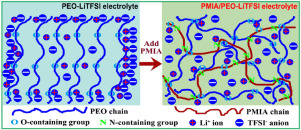Journal of Energy Chemistry ( IF 14.0 ) Pub Date : 2020-02-28 , DOI: 10.1016/j.jechem.2020.02.033 Lehao Liu , Jinshan Mo , Jingru Li , Jinxin Liu , Hejin Yan , Jing Lyu , Bing Jiang , Lihua Chu , Meicheng Li

|
Polyethylene oxide (PEO)-based electrolytes have obvious merits such as strong ability to dissolve salts (e.g., LiTFSI) and high flexibility, but their applications in solid-state batteries is hindered by the low ion conductance and poor mechanical and thermal properties. Herein, poly(m-phenylene isophthalamide) (PMIA) is employed as a multifunctional additive to improve the overall properties of the PEO-based electrolytes. The hydrogen-bond interactions between PMIA and PEO/TFSI− can effectively prevent the PEO crystallization and meanwhile facilitate the LiTFSI dissociation, and thus greatly improve the ionic conductivity (two times that of the pristine electrolyte at room temperature). With the incorporation of the high-strength PMIA with tough amide-benzene backbones, the PMIA/PEO-LiTFSI composite polymer electrolyte (CPE) membranes also show much higher mechanical strength (2.96 MPa), thermostability (419 °C) and interfacial stability against Li dendrites (468 h at 0.10 mA cm‒2) than the pristine electrolyte (0.32 MPa, 364 °C and short circuit after 246 h). Furthermore, the CPE-based LiFePO4/Li cells exhibit superior cycling stability (137 mAh g−1 with 93% retention after 100 cycles at 0.5 C) and rate performance (123 mAh g−1 at 1.0 C). This work provides a novel and effective CPE structure design strategy to achieve comprehensively-upgraded electrolytes for promising solid-state battery applications.
中文翻译:

具有多功能PMIA的全面改性聚合物电解质膜,用于高度稳定的全固态锂离子电池
基于聚环氧乙烷(PEO)的电解质具有明显的优点,例如强大的溶解盐的能力(例如LiTFSI)和高柔韧性,但是由于离子传导率低以及机械和热性能差,它们在固态电池中的应用受到了阻碍。在本文中,聚(间亚苯基间苯二甲酰胺)(PMIA)用作多功能添加剂以改善基于PEO的电解质的整体性能。PMIA和PEO / TFSI之间的氢键相互作用-可以有效防止PEO结晶,同时促进LiTFSI的离解,从而大大提高了离子电导率(是室温下原始电解质的两倍)。通过将高强度PMIA与坚硬的酰胺-苯骨架结合使用,PMIA / PEO-LiTFSI复合聚合物电解质(CPE)膜也显示出更高的机械强度(2.96 MPa),热稳定性(419°C)和抗界面稳定性锂比原始电解质(0.32 MPa,364°C,246 h后短路)产生树枝状结晶(在0.10 mA cm ‒ 2时468小时)。此外,基于CPE的LiFePO 4 / Li电池还具有出色的循环稳定性(在0.5 C循环100次后137 mAh g -1,保持93%的保留)和速率性能(123 mAh g-1在1.0 C)。这项工作提供了一种新颖而有效的CPE结构设计策略,以实现用于有前途的固态电池应用的全面升级的电解质。











































 京公网安备 11010802027423号
京公网安备 11010802027423号